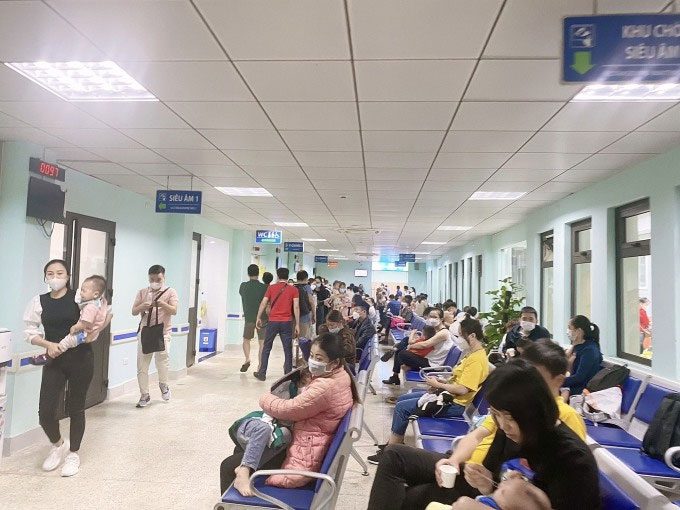Experts believe that the phenomenon of “immunity debt” during the lockdown period has hindered children’s immune systems from being trained, leading to a higher risk of illness as society reopens.
On November 17, Associate Professor Dr. Nguyen Thi Dieu Thuy, Head of the Pediatrics Department at Hanoi Medical University, stated that “immunity debt” is a phenomenon that occurs when individuals do not regularly come into contact with bacteria and viruses.
Specifically, in children, natural immunity develops after exposure to viruses and bacteria; however, this ability has been limited or even halted during the pandemic. This has resulted in children experiencing immunity debt or a lack of immune stimulation due to reduced exposure.
Additionally, some experts analyze that children are most susceptible to infections at the age of two. This is a critical time for the immune system to be trained, encountering many viruses to become stronger. However, after two years of social distancing, many children have never been infected.
Moreover, the restrictions during the Covid-19 period have inadvertently significantly reduced the spread of respiratory diseases, weakening the immune system. Additionally, children infected with Covid-19 (whether symptomatic or not) have also had their immune responses affected, making their conditions more severe when they do get sick.
Aside from immune deficiencies, changing weather, humidity, and fluctuating temperatures create conditions conducive to the spread of viruses and bacteria, causing many children to fall ill continuously.
In northern provinces, especially Hanoi, many diseases are currently surging simultaneously, overwhelming healthcare facilities. For instance, the Central Pediatric Hospital has recorded over 3,000 cases of Adenovirus since the beginning of the year, with nine children succumbing to the illness, including cases with no underlying health conditions. The number of cases and deaths has doubled or tripled compared to the same period in 2021.
Similarly, in October, doctors at Thanh Nhan Hospital had to be on duty 24/7, with some nights seeing up to 20 children in emergency care. Duc Giang General Hospital received over 1,500 children for examination and treatment, previously averaging around 1,000 children per day.
In the southern region, respiratory illnesses have also increased due to the end of the rainy season. For example, the Ho Chi Minh City Children’s Hospital has been admitting between 1,500 to 2,000 children with respiratory illnesses for examination daily since early September.

Recently, the number of children with infectious diseases has surged, and hospitals are always overloaded and full. (Photo: Thuy An).
Despite the rapid increase in cases, Dr. Truong Huu Khanh, Vice President of the Ho Chi Minh City Infectious Disease Association, stated that people should not be overly worried as most respiratory illnesses will resolve on their own. Meanwhile, Associate Professor Dr. Do Van Dung, Head of the Community Health Department at Ho Chi Minh City University of Medicine and Pharmacy, recommended that patients only need to reduce fever and pain with medication, stay hydrated (with water, fruit juices, or electrolyte solutions), and do not require intravenous fluids.
“There is a risk of severe illness in vulnerable groups such as the elderly, immunocompromised individuals, those with underlying conditions, and young children… so one should not be complacent, but also not overly anxious,” the associate professor advised.
One health expert suggested that if more people become infected in the coming months, leading to a significant flu outbreak, the “immunity debts” will be settled.
To boost immunity, experts recommend that parents enhance their children’s nutrition, particularly by adding iron and zinc to their diets. They should increase protein-rich foods such as meat, fish, and eggs; whole grains; low-fat dairy products; and fresh fruits and vegetables rich in vitamins, especially vitamin C. If children are fatigued or have a poor appetite, it is advisable to divide meals into 5-6 smaller portions throughout the day to make eating easier and improve nutrient absorption.
Regular personal hygiene practices should be maintained, such as covering the mouth when sneezing, washing hands with soap and clean water, and daily nasal and throat hygiene with saline solution. A balanced diet is essential for enhancing overall health. It is advisable to limit contact with flu patients or suspected cases when unnecessary.
If a child has a fever above 38.5 degrees Celsius, fever-reducing medications like paracetamol can be used, with dosage based on body weight. Absolutely do not self-medicate or administer intravenous fluids at home.
Children who are unable to eat or drink, have difficulty breathing, exhibit rapid breathing, show retraction of the chest wall, have a high fever lasting two to five days, or do not respond to fever-reducing medication should be taken to the hospital immediately.


















































